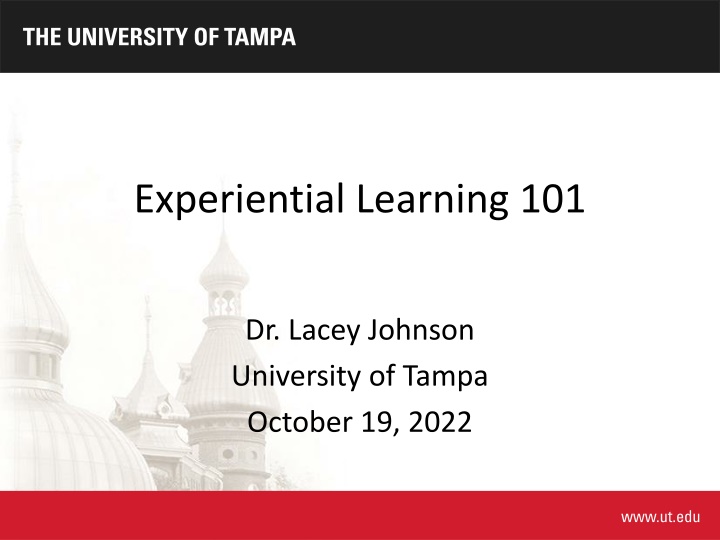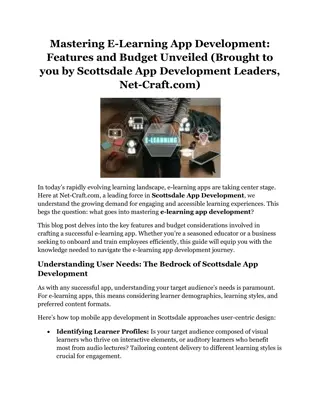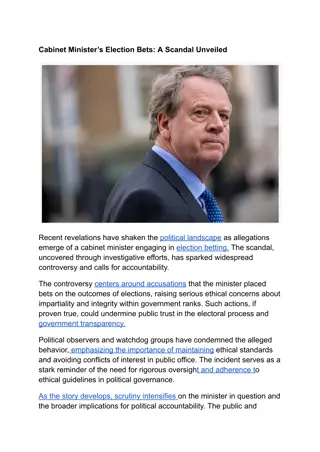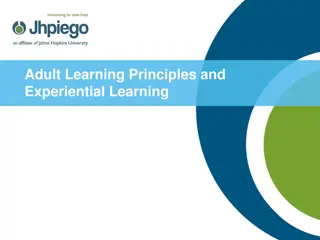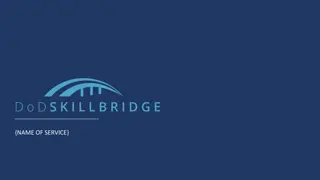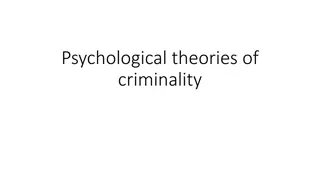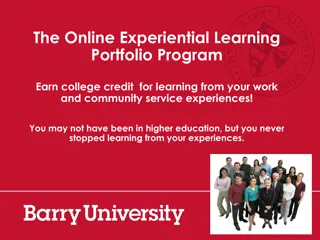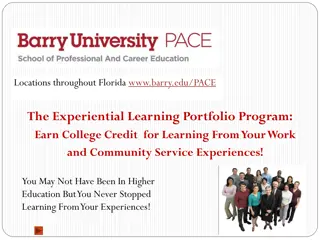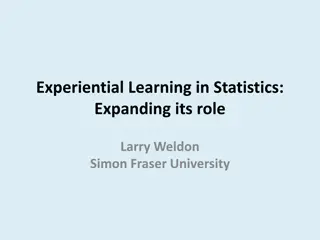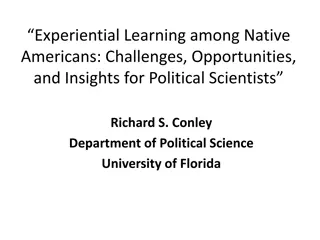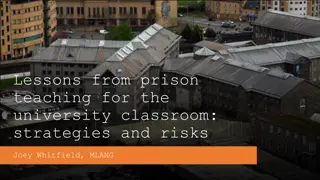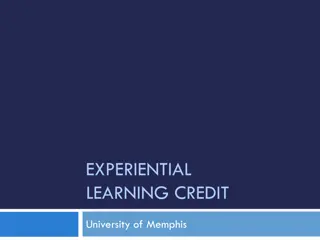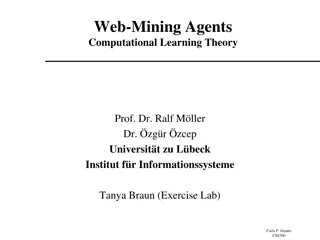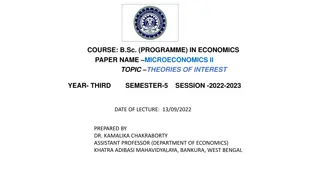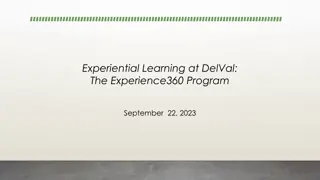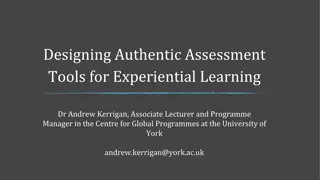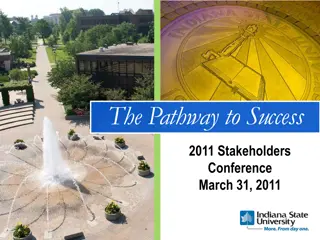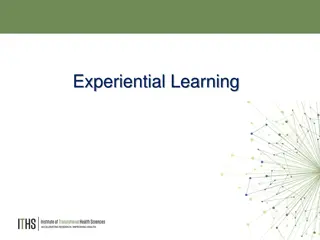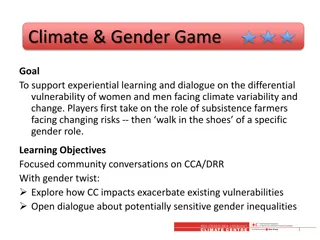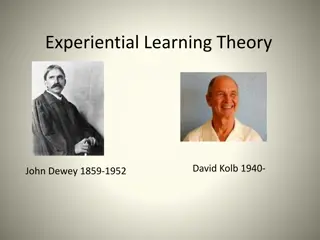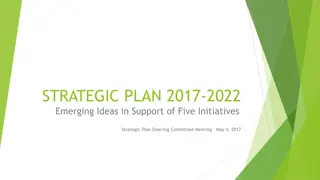Experiential Learning Theory Unveiled
Experiential Learning Theory, pioneered by David Kolb, emphasizes learning through hands-on experiences, reflection, and application of ideas. This interactive process involves four key stages: Concrete Experience, Reflective Observation, Abstract Conceptualization, and Active Experimentation. By engaging students in real-world scenarios, teachers facilitate a deeper understanding of concepts learned in the classroom.
Download Presentation

Please find below an Image/Link to download the presentation.
The content on the website is provided AS IS for your information and personal use only. It may not be sold, licensed, or shared on other websites without obtaining consent from the author.If you encounter any issues during the download, it is possible that the publisher has removed the file from their server.
You are allowed to download the files provided on this website for personal or commercial use, subject to the condition that they are used lawfully. All files are the property of their respective owners.
The content on the website is provided AS IS for your information and personal use only. It may not be sold, licensed, or shared on other websites without obtaining consent from the author.
E N D
Presentation Transcript
Experiential Learning 101 Dr. Lacey Johnson University of Tampa October 19, 2022
Outline Experiential learning theory Examples Benefits Challenges Discussion
Experiential Learning Theory David Kolb is best known for his work on experiential learning theory. He was influenced by the work of John Dewey, Kurt Lewin, and Jean Piaget. Experiential learning is the process of learning by doing. Learning is the process whereby knowledge is created through the transformation of experience. -Kolb
Experiential Learning Theory By engaging students in hands-on experience and reflection, they are better able to connect theories and knowledge learned in the classroom to real- world situations. Teachers can help create environments where students can learn and have experiences at the same time.
ELT works in four stages: Effective learning is seen as the learner goes through the cycle. They can enter into the cycle at any time. 1. Concrete learning 2. Reflective observation 3. Abstract conceptualization 4. Active experimentation
Concrete Experience When a learner gets a new experience, or interprets a past experience in a new way
Reflective Observation Learner reflects on their experience personally Learner uses the lens of their experience and understanding to reflect on what this experience means Identify any inconsistencies between experience and understanding Example in the classroom: Ask probing or motivating questions, mini-quizzes, or minute paper
Abstract Conceptualization Learning from the experience Learner forms new ideas or adjusts their thinking based on the experience and their reflection about it
Active Experimentation Learner applies new ideas to the world to see if there are any modifications to be made This process can happen over a short period of time, or over a long period of time
Example: Baking banana bread for the first time 1. You remove the banana bread from the oven and notice the top is burnt, but the inside is raw. (concrete experience) You check to see if you followed the recipe. (reflective observation) You determine that your oven was too hot, and you need to bake the banana bread for longer and at a lower temperature. (abstract conceptualization) You try again, but this time you adjust the temperature and baking time. (active experimentation) Your second attempt results in a new concrete experience, and the cycle of learning continues. 2. 3. 4. 5.
Example: Baking banana bread for the first time There are two goals in the experiential learning process 1. Learning the specifics of a particular subject 2. Learning about your own learning process While breaking banana bread you have: 1. Learned some specifics about baking 2. Learned something about how you build your baking knowledge through trial and error
Learning Styles Learners will have their own preferences for how they enter the cycle Example: Learning how to drive a car Learning via reflection by observing other people as they drive Start more abstractly by reading and analyzing a driving instruction book Jump right in and get behind the seat of a car to practice driving on a test course
Learning Styles Kolb described learning styles as the way students prefer to process new information including strategies that are consistently adopted to learn Understanding a student s learning style enables learning to be orientated according to a preferred method A student may favor more than one learning style
Learning Styles Diverging (feeling and watching) These learners are able to look at things from a unique and different perspective. They prefer to watch rather than do, tending to gather information and use imagination to solve problems. They are interested in people, tend to be imaginative and emotional, and tend to be strong in the arts. History, political science, English, psychology, art, and communication majors Have concrete experience and reflective observation as dominant learning abilities
Learning Styles Assimilating (watching and thinking) Prefer a concise, logical approach Ideas and concepts are more important than people Require clear explanations rather than a practical opportunity Important for effectiveness in information and science careers Economics, mathematics, sociology, chemistry, physics, biology, education, law, social science majors Have abstract conceptualization and reflective observation as dominant learning abilities
Learning Styles Converging (doing and thinking) Problem solvers Prefer technical tasks and problems than social or interpersonal issues Best at finding practical uses for ideas and theories Like to experiment with new ideas, to simulate, and work with practical applications Nursing, health, economics, computer science and engineering majors Have abstract conceptualization and active experimentation as dominant learning abilities
Learning Styles Accommodating (doing and feeling) Hands-on learning style Relies on intuition rather than logic Prefer to take a practical, experiential approach Attracted to new challenges and experiences Rely on others for information then carry out their own analysis Business, fine arts, history, political science, psychology, foreign language majors Have concrete experience and active experimentation dominant learning abilities
Examples of Experiential Learning Community service Service-learning Field Education Internships Undergraduate research Study abroad Student teaching Capstone projects Field trips Mock trials Role playing Classroom games Case studies Science experiments Art projects
Example: Community Service Students dedicate themselves to a cause that meets local community or global needs and integrated with the course work. Recycling, hunger awareness, environmental improvement, etc. Students learn more about the cause and what is needed to be done to ensure the cause is dealt with effectively
Examples: Service-learning A pre-med student in a course on Physiology of the Aging might apply theories and skills learned in the course to providing mobility assistance to seniors at the local senior citizen center. Providing a service to the seniors and helps students to better understand concepts from the course.
Example in Psychology PSY 210 Has students choose a nonprofit organization where they volunteer with children for 30 hours. They complete of series of eight, two to three page papers where they are asked to link their experiences volunteering with course material.
Example: Field education Students spending time providing a service to a social service agency, school, or health agency. Students in an education program spending time as student teachers to improve their teaching skills and learn more about the teaching process.
Example: Internship Primary focus is to provide students with hand on experience that enhance their learning. A political science major might engage in an internship at city hall to learn more about how local government works. A legal studies student doing an internship to learn more about legal skills and how a law firm operates.
Example in Marine Science-Biology Madison Schorle, a marine science-biology major, worked as a nesting intern at the Clearwater Marine Aquarium getting hands-on experience to help sea turtles safely lay their eggs. This internship has been a really great experience because I ve met all these people from different places around the U.S. who have the same interest as me, said Schorle. I feel like a kid playing outside all day, but I m still learning and I love being able to share everything I learn with other people so that they can help the environment, too. She looks forward to taking what she s learned in the field back to her UT classrooms.
Example in Film and Media Arts Warren Cockerham, media production coordinator, and Gregg Perkins, associate professor of film, animation, and new media, brought their film and media art students to the Diamond View set to work with innovative LED volume technology by filming and producing a short film. It s a really healthy gift to make sure that the students are learning properly and maybe they can go use this technology in their own careers later on, said Perkins, UT Associate Professor of Film, Animation, and New Media One student said, It has been really beneficial to see set etiquette and team building. Getting to work with a bigger team was a great way to see everyone else s strengths and figure out how to work together in the best way.
Examples in Criminology Field trips to jails, crime laboratories, mental health facilities, and police departments Mock crime scene
Example: Interviewing Develop questions and practice interviewing with their classmates to build experience Reflect on their experience What went well? What needed more work? Now they act based on their thoughts and reflections by conducting interviews outside of the classroom By acting, learners develop new experiences that they may subject to another round of the process.
Example in Mathematics Using origami to prove mathematical concepts Graphing transformations of functions
Benefits of Experiential Learning Opportunity to immediately apply knowledge Promotion of teamwork Improved motivation Opportunity for reflection Real world practice Creates stronger connections between educational and lived experiences
Challenges Limited class time Limited access to resources Curriculum constraints Inadequate group work skills Overwhelming for the teacher
Discussion What are some ways you incorporate experiential learning in your classes? How could incorporate experiential learning into your own classroom?
References and Resources https://www.shsu.edu/academics/cce/documents/Service_Learning_Balanced_Ap proach_To_Experimental_Education.pdf https://www.ut.edu/news-and-ut-life/ut-senior-spends-summer-helping-nesting- sea-turtles- https://www.ut.edu/news-and-ut-life/ut-film-students-work-with-innovative-led- volume https://www.wgu.edu/blog/experiential-learning-theory2006.html#close https://teacher.desmos.com/activitybuilder/custom/566b31784e38e1e21a10aade ?collections=featured-collections%2C5e73b204d560367270838c4b
